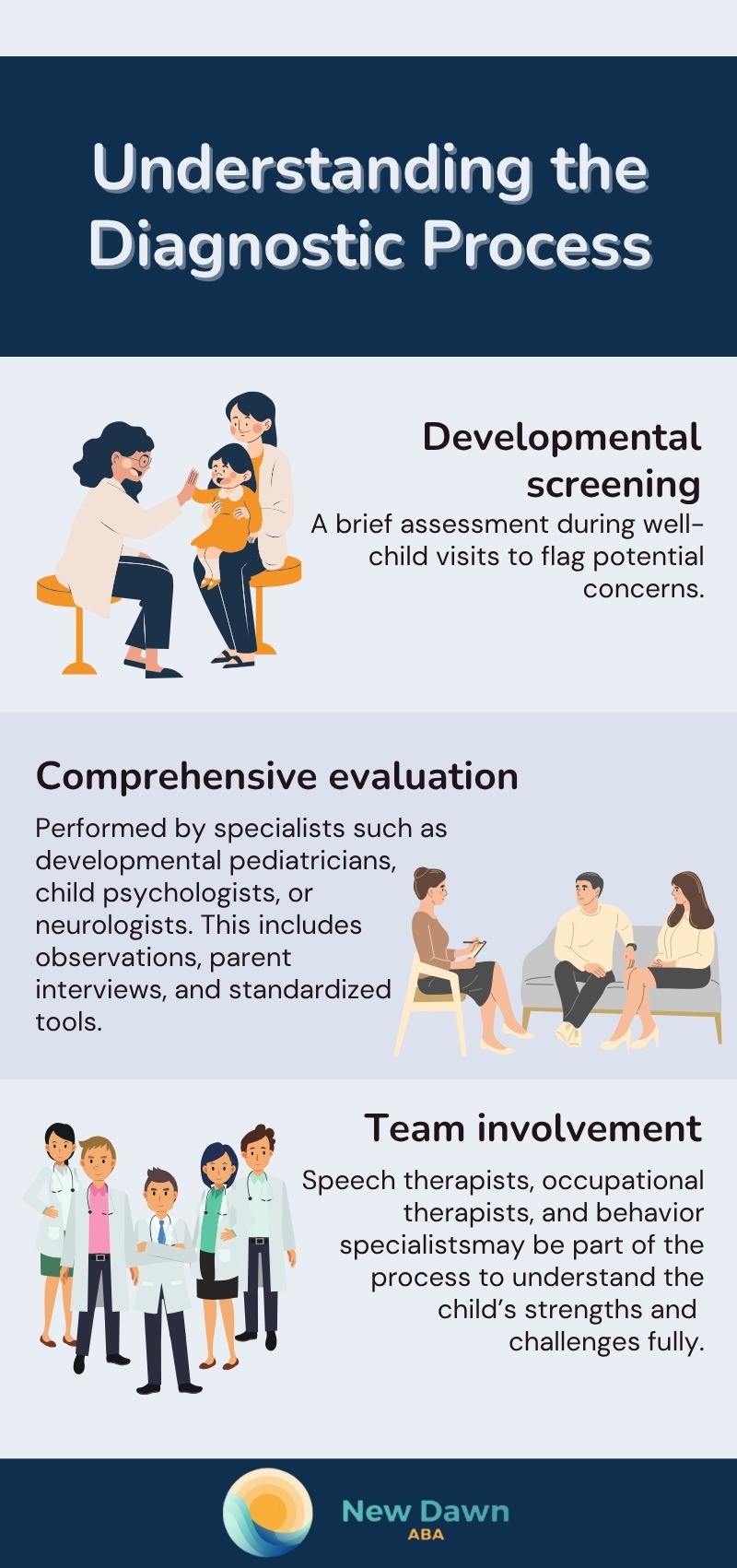Key Points:
- Autism spectrum disorder (ASD) affects how a child communicates, interacts, and experiences the world, and early understanding can lead to better support.
- A parent's guide to autism spectrum disorder should include clear insights into diagnosis, common behaviors, and practical coping strategies.
- Support systems, therapy options like ABA, and an empathetic home environment are critical in helping children with autism thrive.
When a parent first hears the words “autism spectrum disorder” in relation to their child, it can feel overwhelming. There may be questions, fears, and confusion about what this means for the future. Each child is different, and while the journey ahead may have unique challenges, it is also filled with opportunities for growth, connection, and progress.
Navigating autism as a parent involves learning to understand your child’s behaviors, building a supportive environment, and finding the right resources. A parent's guide to autism spectrum disorder aims to do exactly that—offer direction, clarity, and compassion as you move forward. Whether your child has just received a diagnosis or you’ve been searching for answers for a while, this guide is designed to help you find stability and hope.
Is Autism Spectrum Disorder Something That Can Be Managed?
Yes, autism spectrum disorder can be managed with the right support, early intervention, and consistent care. While there is no “cure” for autism, many children on the spectrum lead fulfilling lives when given the tools they need to thrive. A parent's guide to autism spectrum disorder is most effective when it helps families understand both the challenges and the strengths associated with ASD.
Autism is a developmental condition that affects how children communicate, relate to others, and process sensory experiences. It is called a “spectrum” because the signs, behaviors, and severity levels vary widely between individuals. Understanding this variability is key to creating tailored support systems for each child.
Recognizing Early Signs Of Autism
Early identification can make a meaningful difference. Most signs of autism appear before age three, though they might be subtle at first. Parents are often the first to notice when something seems “different” in their child’s development.
Here are some early indicators parents should be aware of:
- Limited eye contact or facial expressions
- Delayed speech or language milestones
- Repetitive behaviors (hand flapping, lining up toys, spinning)
- Unusual sensitivity to sound, touch, or light
- Lack of interest in playing with peers or sharing experiences
- Difficulty understanding or expressing emotions
If any of these behaviors are observed consistently, it’s important to speak with a pediatrician or developmental specialist for an evaluation.
Understanding The Diagnostic Process
Diagnosis usually involves a multi-step process that includes:

A confirmed diagnosis helps unlock access to early intervention services, educational supports, and therapies tailored to the child’s unique needs.
Common Challenges Faced By Children With Autism
Every child on the spectrum is different, but there are common areas where many need support. Understanding these challenges is essential in guiding care and creating a nurturing environment.
Communication Difficulties
Children with autism may have delayed language development or struggle with non-verbal cues like gestures or facial expressions. Some may be non-speaking and rely on alternative communication tools.
Social Interaction Differences
They might find it difficult to make friends, understand social norms, or interpret other people's emotions. This doesn’t mean they lack the desire to connect—it means they often need support in learning how.
Repetitive Behaviors And Routines
Many children with autism engage in repetitive actions or insist on strict routines. These behaviors can be calming and serve an important emotional or sensory function.
Sensory Processing Issues
Some children are overly sensitive to certain sounds, lights, textures, or smells, while others may seek out intense sensory input. This can influence behavior, eating habits, and even sleep patterns.

What Can Parents Do To Support Their Child?
A parent's guide to autism spectrum disorder is only complete when it empowers caregivers with concrete, actionable steps. While the path isn’t always linear, there are key strategies that consistently support children on the spectrum.
Learn And Observe
Understanding your child’s unique sensory preferences, triggers, and comfort zones is essential. Keep a journal, notice patterns, and share this information with therapists or educators.
Build Predictable Routines
Children with autism often thrive with structure. Use visual schedules, timers, or clear routines to reduce anxiety and help them anticipate what’s coming next.
Encourage Communication
Whether your child speaks verbally or uses tools like picture exchange systems, encourage all forms of expression. Celebrate progress and create opportunities for your child to communicate their needs.
Create A Sensory-Friendly Environment
Adjust lighting, reduce loud noises, or provide sensory toys like fidget tools or weighted blankets. Sensory accommodations can significantly improve comfort and behavior.
Involve Therapists And Educators
Working with professionals like ABA therapists, speech-language pathologists, and occupational therapists can create a holistic support system. Regular collaboration ensures consistent progress across settings.
The Role Of Applied Behavior Analysis (ABA) Therapy
ABA is one of the most widely researched and effective approaches for helping children with autism develop essential skills. It focuses on reinforcing positive behaviors, teaching new skills, and reducing behaviors that interfere with learning or daily life.
Key components of ABA therapy include:
- Individualized treatment plans based on assessments
- One-on-one sessions that focus on communication, social, academic, and daily living skills
- Parent training and involvement to ensure consistent progress at home
- Data-driven goals that track improvements over time
Children of all ability levels can benefit from ABA therapy when it’s adapted to their needs and led by compassionate professionals.
Building A Support System
Parenting a child with autism can feel isolating at times, but no family should walk this path alone. Support networks provide emotional strength and practical knowledge.
Here are a few ways to build your village:
- Join local or online parent support groups to share experiences, advice, and encouragement.
- Connect with advocacy organizations that offer educational workshops, newsletters, and events.
- Engage with your child’s school or therapy team regularly to ensure collaboration and alignment.
- Seek respite care when needed—parenting is demanding, and self-care is not a luxury but a necessity.
Compassion, Patience, And Progress
Above all, remember that children with autism have immense potential. Progress may come in small steps, but every milestone—whether it’s making eye contact, trying a new food, or saying a new word—is worth celebrating. Parenting a child with autism involves growth for the entire family. The more informed, supported, and empowered a parent feels, the more they can help their child thrive.
Empower Your Child’s Future With ABA Therapy
Navigating autism is a journey that requires the right support, both emotionally and practically. New Dawn ABA is committed to helping families through professional, evidence-based ABA therapy in Missouri and Colorado. Our team works with children on the spectrum to build communication, social skills, and independence—tailoring every plan to your child’s individual strengths and challenges.
If you’re looking for expert support and compassionate care, contact us today. With structured therapy and a deep understanding of your child’s needs, together we can build a brighter future—step by step, with hope and purpose.
Recent articles

At New Dawn ABA, we believe in brighter beginnings. Our team partners with families to build skills that matter—turning daily moments into meaningful progress and long-term independence.

.svg)
.svg)
.svg)
Quick Links
HomeAbout UsServicesLocationsResourcesCareersContact UsPrivacy PolicyOur Locations
MissouriColoradoKansasOklahoma (Coming Soon)Contact Information
.png)
720-784-4944
.png)
720-784-4945
.png)
info@newdawnaba.com
Copyright © 2025 New Dawn ABA - All Rights Reserved.



.jpg)
